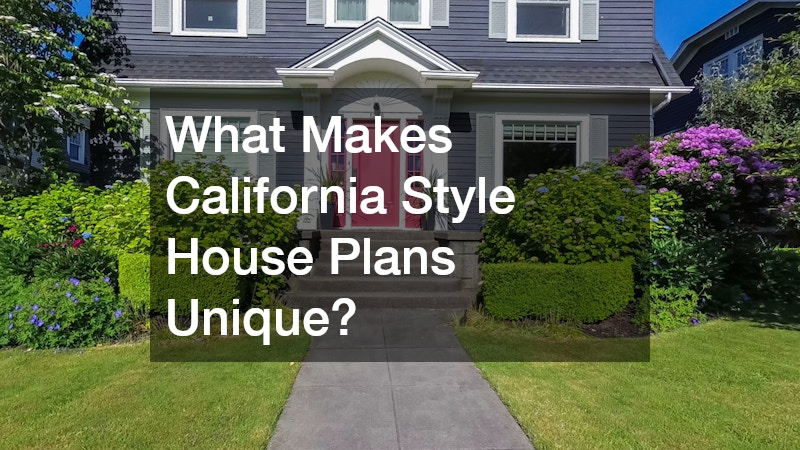California style house plans are a distinctive blend of architectural charm, functional design, and lifestyle enhancement that reflect the unique climate, culture, and natural beauty of the Golden State. Emerging from the intersection of Spanish, Mediterranean, and modernist influences, these house plans have evolved to meet the changing needs of residents while maintaining their signature indoor-outdoor connection and emphasis on sustainability. As demand continues to grow for homes that support energy efficiency, flexible living spaces, and harmonious integration with the environment, California style house plans stand at the forefront of modern architectural innovation.
One of the key reasons these plans have garnered attention is their adaptability. Whether it’s a modest single-story home nestled in a quiet suburb or a luxurious hillside retreat overlooking the Pacific, California house designs accommodate a wide range of lifestyles and budgets. These homes frequently incorporate smart technologies, eco-friendly materials, and design techniques that make them both beautiful and resilient, an especially important factor in a state prone to wildfires, droughts, and earthquakes.
Furthermore, California style homes reflect the cultural diversity and laid-back ethos of the state’s population. The interiors often merge comfort and sophistication, prioritizing open spaces, natural light, and seamless transitions between indoor and outdoor areas. This dynamic blend of style, substance, and sustainability is what makes California house plans more than just a regional preference — they are a growing trend in residential design nationwide.

1. What are California Style House Plans?
California style house plans are more than just blueprints — they are reflections of the state’s history, environment, and cultural evolution. Historically, these designs trace back to the early Spanish missions and Mediterranean influences that shaped much of California’s early architecture. Features like red tile roofs, stucco walls, and arched entryways gave way to more contemporary updates in the 20th century, with mid-century modern and contemporary styles gaining popularity.
One defining feature of these homes is their focus on open spaces and connectivity, particularly between indoor and outdoor areas. This is a natural extension of California’s climate, which encourages alfresco living throughout the year. Whether through expansive sliding glass doors or well-designed courtyards, these homes often dissolve the boundaries between inside and outside.
Over time, California style house plans have adapted to modern needs. Today, they frequently feature smart home technology, energy-efficient systems, and flexible layouts that accommodate remote work and multi-generational living. Architectural influences remain diverse, blending traditional, contemporary, and even industrial elements such as exposed carbon steel pipe fitting components for structural or aesthetic flair. The regional variability — from beach bungalows in Southern California to hillside retreats in the Bay Area — further contributes to their uniqueness.
2. How Do California Style Homes Incorporate Indoor-Outdoor Living?
One of the most striking aspects of California style house plans is their seamless incorporation of indoor-outdoor living, a design philosophy rooted in the state’s temperate climate and lifestyle preferences. Open floor layouts act as the foundation for this integration, creating spaces that feel expansive and inviting. Living rooms often flow effortlessly into dining areas and kitchens, which then extend to patios and decks without interruption.
Large windows and sliding or folding glass doors are a staple in these homes, allowing natural light to flood interior spaces while providing unbroken views of gardens, courtyards, or scenic vistas. The transparency not only enhances visual appeal but also supports passive solar heating and cooling, promoting energy efficiency. Custom framing services are frequently employed to create bespoke window and door openings that maximize these benefits.
Landscaping plays a critical role in enhancing the outdoor experience. Thoughtfully designed spaces may include everything from drought-tolerant gardens and water features to fire pits and outdoor kitchens. These areas serve as extensions of the indoor living environment, facilitating a lifestyle that encourages relaxation and social connection. Attention to floor care in both indoor and outdoor transitional spaces is essential, ensuring surfaces are both functional and aesthetically pleasing.
Incorporating features like retractable awnings, pergolas, and thermal insulation covers over outdoor living zones further enhances year-round usability. Such additions not only provide comfort but also reflect a commitment to practical luxury. Ultimately, this fusion of interior and exterior environments is central to the California home experience.
3. What Materials Are Commonly Used in California Style House Plans?
The materials used in California style house plans reflect a commitment to sustainability, natural beauty, and regional practicality. Sustainable materials are often prioritized, including reclaimed wood, recycled metal, and low-VOC finishes. These elements contribute to healthier living environments and align with broader goals of environmental responsibility.
Natural stone and wood are prominently featured throughout these homes. From rustic wood beams in living rooms to stone-clad fireplaces and exterior facades, these materials add warmth and texture. Their organic appearance helps blend the home with the surrounding landscape, creating a sense of unity and harmony. Builders often leverage local resources to reduce transportation costs and environmental impact.
Glass and steel are also key components, especially in modern iterations of California style homes. Floor-to-ceiling glass panels allow for uninterrupted views and ample sunlight, while steel provides structural strength and design flexibility. In some cases, carbon steel pipe fitting is used as both a structural necessity and a decorative feature, particularly in industrial or contemporary designs.
Traditional materials like stucco and adobe remain popular as well, especially in Mediterranean or Spanish Colonial-inspired homes. These materials offer excellent insulation and are well-suited for the state’s varied climate. When integrated with other materials, they create a balanced aesthetic that bridges old and new.
The use of regionally available materials not only supports the local economy but also ensures that homes are well-suited to California’s diverse environmental conditions. From the desert heat of Palm Springs to the coastal moisture of Monterey, material choices are carefully tailored to ensure longevity and performance.

4. How Do California Style Plans Address Energy Efficiency?
Energy efficiency is a core principle in California style house plans, driven by both environmental values and state regulations. Solar panel integration is a common feature, capitalizing on California’s abundant sunshine to reduce electricity costs and carbon footprints. Many new builds include rooftop solar systems as standard, contributing to the state’s broader renewable energy goals.
Energy-efficient windows and insulation materials are also widely utilized. Double- and triple-pane windows with low-emissivity coatings help regulate indoor temperatures while minimizing heat loss. High-quality insulation in walls, roofs, and even thermal insulation covers for HVAC components enhances energy performance and occupant comfort.
Passive cooling techniques, such as strategic window placement and natural ventilation, reduce the need for air conditioning. Homes are often designed with overhangs or shaded areas that block the summer sun while allowing winter light to enter. Building orientation plays a vital role in this strategy, ensuring that homes benefit from optimal solar exposure throughout the year.
Smart home technologies further boost energy efficiency. From programmable thermostats and lighting systems to energy monitoring tools, these technologies allow homeowners to track and reduce consumption. Integration with energy management systems ensures that power usage is optimized, reducing strain on both the environment and household budgets.
Even construction practices reflect this focus. Builders often emphasize site readiness before breaking ground to minimize waste and environmental disruption. This preparation includes evaluating solar access, drainage, and insulation strategies to ensure the home’s long-term efficiency and sustainability.
5. What Are the Common Architectural Styles Found in California?
California style house plans are characterized by a diverse range of architectural styles, each with its own unique history and visual identity. Mediterranean Revival is one of the most iconic, featuring stucco exteriors, red tile roofs, and arched openings. Inspired by Spanish and Italian architecture, this style exudes a sense of old-world elegance and is well-suited to California’s warm climate.
Spanish Colonial homes are similar but tend to be more modest in scale. They often feature whitewashed walls, wrought iron details, and intimate courtyards. These homes pay homage to the state’s colonial past and are popular in both urban and rural settings.
Mid-century Modern is another influential style, characterized by clean lines, open spaces, and a strong indoor-outdoor connection. Large windows, flat planes, and integration with the landscape are hallmarks of this design. It often includes innovative materials like carbon steel pipe fitting and glass, offering both durability and modern flair.
Mission Revival architecture, a close cousin to Spanish Colonial, emphasizes simplicity and function. Key features include smooth stucco walls, parapets, and curved gables. This style echoes the design of California’s historic missions and blends seamlessly with the environment.
Contemporary California architecture pushes boundaries with minimalist forms, eco-friendly materials, and smart technology. These homes often employ custom framing services to accommodate bold design choices and expansive glass walls. Whether rooted in tradition or pushing modern limits, California’s architectural diversity reflects its rich cultural and geographic landscape.
6. How Do California Style House Plans Embrace Sustainability?
Sustainability is woven into the fabric of California style house plans, reflecting both environmental consciousness and regulatory standards. Water-efficient features such as low-flow fixtures, drip irrigation systems, and drought-tolerant landscaping are commonly included to combat water scarcity and reduce utility costs.
Recycled materials play a significant role in the construction process. Builders often use reclaimed wood, recycled concrete, and sustainable insulation materials to minimize the environmental impact of new builds. These choices contribute to lower carbon footprints and align with California’s green building initiatives.
Eco-friendly construction practices, such as reducing waste during site readiness and selecting non-toxic finishes, are also emphasized. Modular home companies are increasingly turning to prefab and modular techniques to cut construction time and material waste while still achieving high-quality, sustainable homes.
Landscape integration goes beyond aesthetics. Native plants, rain gardens, and permeable paving systems are used to manage stormwater and support biodiversity. These elements enhance the visual appeal while promoting ecological health.
Certifications and standards, including LEED and CALGreen, guide the development of sustainable California homes. These benchmarks ensure that energy use, water conservation, and material selection meet or exceed environmental expectations, solidifying California’s role as a leader in green architecture.

7. What Role Does Technology Play in Modern California Homes?
Technology plays a pivotal role in modern California homes, enhancing convenience, efficiency, and safety. Home automation systems control lighting, climate, security, and even irrigation with the touch of a button or voice command. This level of control not only adds luxury but also improves energy management.
Smart appliances, including refrigerators, ovens, and washers, are now common in California kitchens and laundry rooms. These devices offer features like remote monitoring, energy usage tracking, and integration with home assistants. Combined with energy-efficient design, they contribute to a lower environmental impact.
Energy management systems take this further by optimizing how and when power is used throughout the home. Solar panels, battery storage, and grid-tied systems are coordinated for peak efficiency, often through a central hub. This technology helps homeowners save money while reducing dependence on non-renewable energy sources.
Security innovations include video doorbells, smart locks, and surveillance systems that can be accessed from anywhere via smartphone. These features provide peace of mind and are especially valuable in areas where wildfire or seismic activity necessitates quick evacuation or remote monitoring.
Connectivity and entertainment systems are also key. High-speed internet, integrated sound systems, and media centers ensure that homes meet the demands of modern digital life. From work to relaxation, technology in California style homes enhances every aspect of daily living.
8. How are California Style Homes Adapted for Seismic Safety?
Seismic safety is a critical consideration in California style house plans due to the state’s susceptibility to earthquakes. Foundation design is often the first line of defense, with builders opting for deep-set footings, reinforced slabs, or pier-and-beam systems that can absorb and distribute seismic forces.
Reinforcement techniques such as shear walls, braced frames, and reinforced concrete help prevent structural collapse. Engineers frequently incorporate flexural elements like moment-resisting frames that allow buildings to bend slightly without breaking, providing resilience during tremors.
Material selection is equally important. Lightweight materials like engineered wood and steel are preferred because they place less strain on the structure during seismic events. Carbon steel pipe fitting, for instance, offers both strength and flexibility, making it ideal for structural reinforcements.
Compliance with California’s stringent building codes ensures that every home meets minimum seismic standards. Local contractors work closely with inspectors to verify adherence during site readiness, ensuring each component — from framing to finishes — contributes to overall safety.
Finally, modular home companies often design with seismic resistance in mind, using factory-controlled processes to ensure consistent quality and secure connections. This forward-thinking approach makes California homes some of the safest and most advanced in the world.
9. What Interior Design Trends are Popular in California Style Homes?
Interior design in California style homes blends form and function with a distinctively relaxed, modern aesthetic. Minimalist aesthetics dominate, emphasizing clean lines, uncluttered spaces, and purposeful furnishings. This approach not only makes homes feel larger and brighter but also aligns with the broader ethos of simplicity and mindfulness.
Neutral and earth tones — including beige, taupe, soft gray, and natural greens — are widely used to create calming environments that reflect California’s natural surroundings. These palettes pair beautifully with organic materials like reclaimed wood, stone, and linen to bring texture and warmth to the space.
Blending vintage and modern elements is another hallmark of California interior design. A rustic wood table may be paired with sleek metal chairs, or a modern light fixture might illuminate a traditional fireplace. This eclectic mix gives homes a timeless appeal that resists passing fads.
Natural materials and textures are central to the aesthetic. Woven rugs, exposed beams, and stone surfaces evoke a sense of grounded elegance. Floor care is vital in maintaining the beauty of these elements, especially in homes that experience high foot traffic from both indoor and outdoor areas.
Functionality and comfort are paramount. Open-concept layouts prioritize flow and usability, while cozy nooks, built-in storage, and multi-use furniture ensure that every square foot is utilized efficiently. Whether designed by a basement finishing contractor or a custom interior designer, each space is created with real living in mind.

10. How Do California Style House Plans Reflect the Local Culture?
California style house plans are deeply influenced by the state’s rich and diverse cultural tapestry. From the architecture to the layout and décor, every element reflects the multicultural heritage and lifestyle preferences of Californians. The influence of California’s diverse population is evident in the fusion of global design elements — from Asian Zen gardens and Mediterranean courtyards to Latin American color palettes.
These homes often celebrate a lifestyle centered on relaxation, wellness, and luxury. Spacious living areas, spa-like bathrooms, and gourmet kitchens support a high quality of life. At the same time, informal outdoor spaces encourage laid-back gatherings and spontaneous entertaining, hallmarks of the Californian spirit.
California’s architectural legacy, including the Arts and Crafts movement, emphasizes craftsmanship, natural materials, and attention to detail. This legacy continues in modern homes through features like handcrafted tiles, bespoke woodwork, and artisanal finishes. Custom framing services often bring these details to life, adding unique character to each house.
The state’s awe-inspiring landscapes — from coastal cliffs to redwood forests — serve as a constant source of inspiration. Homes are designed to frame these views, blurring the line between built and natural environments. Even practical considerations, like mitigating septic back up or integrating floor care with outdoor access points, are handled with style and grace.
In addition, local roofing services and commercial roofing companies play an important role in ensuring homes are both beautiful and resilient. Whether installing traditional clay tiles or modern solar shingles, these professionals help homeowners stay aligned with both aesthetic and environmental priorities.
The Lasting Impact and Innovation of California Style House Plans
California style house plans are more than architectural blueprints — they are holistic reflections of a region known for innovation, diversity, and an enviable quality of life. From their historical roots in Spanish Colonial and Mediterranean design to their modern expressions in mid-century and contemporary styles, these homes embody a unique blend of aesthetic appeal, practicality, and cultural identity.
What sets California homes apart is their seamless integration of indoor and outdoor spaces, energy-efficient materials and systems, and thoughtful attention to local environmental conditions. By prioritizing site readiness, sustainability, and the latest smart technologies, these homes are designed for the future while honoring the past. Whether incorporating a carbon steel pipe fitting for structural integrity or enlisting custom framing services to maximize natural light, every detail serves a purpose.
Moreover, the professionals involved — from modular home companies to local roofing services, basement finishing contractors, and commercial roofing companies — contribute their expertise to create homes that are as functional as they are beautiful. The inclusion of essential elements like septic back up management and floor care ensures these homes support long-term comfort and resilience.
As design preferences continue to evolve, California style house plans remain a beacon of architectural excellence. Their influence extends far beyond state lines, offering inspiration to homeowners and builders nationwide. With their emphasis on sustainability, smart design, and cultural expression, these homes represent not just a place to live but a way to live well.



